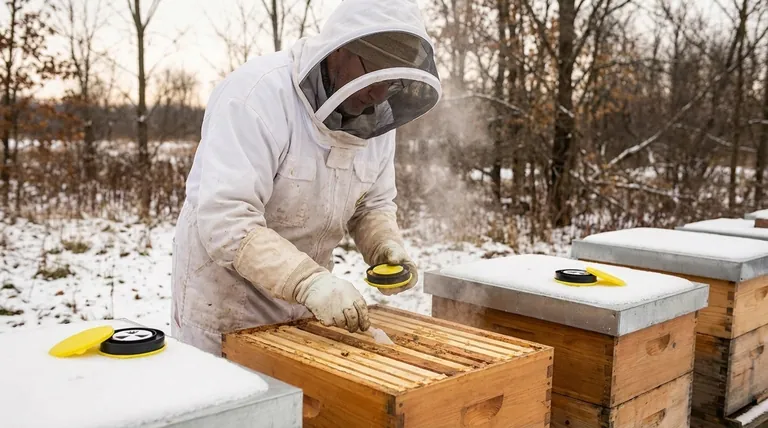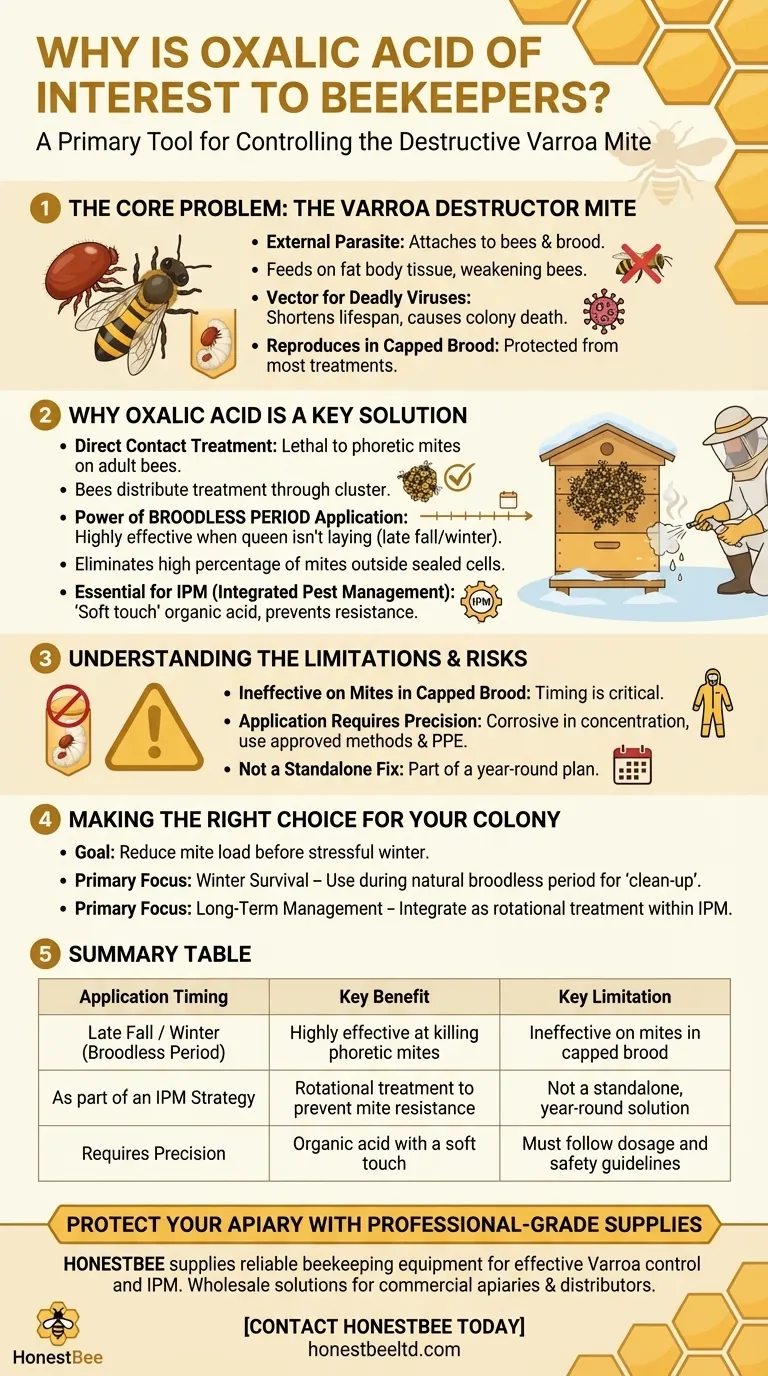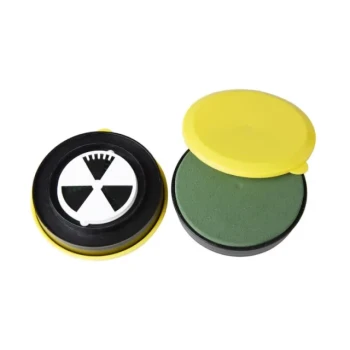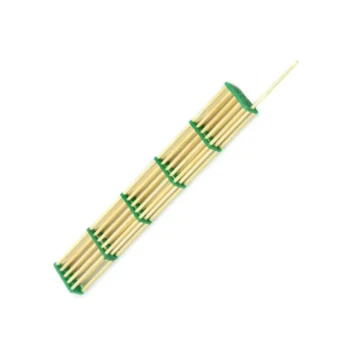For beekeepers, oxalic acid is a primary tool for controlling one of the most destructive pests in modern apiculture: the Varroa mite. It is an organic acid treatment that is highly effective at killing mites when applied correctly, and it has a long history of successful use in Europe, Canada, and now the United States.
The central challenge for any beekeeper is ensuring their colony survives the winter. Oxalic acid is of critical interest because it offers a highly effective, late-season method to significantly reduce Varroa mite populations just before this vulnerable period, directly increasing the colony's chance of survival.

The Core Problem: The Varroa Destructor Mite
A Parasite That Weakens and Kills
The Varroa destructor mite is an external parasite that attaches to both adult honey bees and their developing young (brood). It feeds on the bee's fat body tissue, which is a vital organ responsible for immune function, detoxification, and energy storage.
This feeding action directly weakens the bee, shortening its lifespan. More importantly, the mites act as vectors, transmitting a host of deadly viruses throughout the colony. An unchecked Varroa infestation will almost invariably lead to the death of a honey bee colony.
The Challenge of Mite Reproduction
Varroa mites reproduce within the capped brood cells of a honey bee colony. A female mite enters a cell just before it is sealed, lays several eggs, and the new mites emerge with the young bee.
Because the mites are protected from most treatments while inside these capped cells, controlling their population requires a strategic, multi-faceted approach.
Why Oxalic Acid Is a Key Solution
A Direct Contact Treatment
Oxalic acid works through direct contact. When applied to the bees within a hive, the acid is lethal to the Varroa mites that are physically on the adult bees (known as phoretic mites).
The bees effectively distribute the treatment throughout the cluster as they move and interact, spreading it from bee to bee.
The Power of Broodless Period Application
The single greatest strategic advantage of oxalic acid is its effectiveness during a broodless period. This typically occurs in late fall or early winter after the queen has stopped laying eggs for the season.
When there is no capped brood in the hive, all the mites in the colony are forced onto the bodies of the adult bees. A single oxalic acid treatment at this time can eliminate a huge percentage of the colony's total mite population, as there are no mites hiding in sealed cells.
An Essential Part of Integrated Pest Management (IPM)
Modern beekeeping relies on Integrated Pest Management (IPM), which involves monitoring mite levels and rotating different types of treatments to prevent mites from developing resistance.
Oxalic acid is a "hard chemical" with a "soft touch." It's highly effective but, as an organic acid, is a preferred tool in an IPM strategy. It provides a different mode of action than synthetic miticides, making it an excellent rotational treatment.
Understanding the Limitations and Risks
Ineffective on Mites in Capped Brood
The primary limitation of oxalic acid is its inability to kill mites reproducing within sealed brood cells. Applying it when a colony has a large amount of brood will only kill the phoretic mites, leaving the majority of the mite population untouched and ready to emerge. This is why timing is absolutely critical.
Application Requires Precision
Oxalic acid is a naturally occurring compound, but in its concentrated form, it is corrosive. It is crucial for the beekeeper to use approved application methods (vaporization or dribble), wear appropriate personal protective equipment (PPE), and follow dosage instructions precisely. Overdosing can harm the bees and the queen.
Not a Standalone, Year-Round Fix
Relying solely on an annual oxalic acid treatment is not a complete mite management plan. Mite populations can build to destructive levels during the spring and summer. Beekeepers must monitor mite loads throughout the year and use other control methods as needed.
Making the Right Choice for Your Colony
A late-season oxalic acid treatment is one of the most important actions a beekeeper can take to ensure the long-term health of their bees. The goal is to reduce the mite load to the lowest possible level before the colony enters the stressful winter months.
- If your primary focus is winter survival: Use oxalic acid during a natural broodless period in late fall or early winter to perform a highly effective "clean-up" of the mite population.
- If your primary focus is a long-term management plan: Integrate oxalic acid as a key rotational treatment within a broader IPM strategy, using it at specific times when it will have the maximum impact.
By understanding its power and its limitations, you can use oxalic acid to protect your bees and set them up for a healthy and productive year ahead.
Summary Table:
| Application Timing | Key Benefit | Key Limitation |
|---|---|---|
| Late Fall / Winter (Broodless Period) | Highly effective at killing phoretic mites | Ineffective on mites in capped brood |
| As part of an IPM Strategy | Rotational treatment to prevent mite resistance | Not a standalone, year-round solution |
| Requires Precision | Organic acid with a soft touch | Must follow dosage and safety guidelines |
Protect Your Apiary with Professional-Grade Supplies
As a commercial beekeeper or distributor, effective Varroa mite control is essential for colony survival and productivity. HONESTBEE supplies the reliable beekeeping equipment and supplies you need to implement successful oxalic acid treatments and Integrated Pest Management (IPM) strategies.
We provide wholesale-focused solutions for commercial apiaries and equipment distributors, ensuring you have access to high-quality tools for maintaining healthy, thriving colonies.
Contact HONESTBEE today to discuss your wholesale supply needs and discover how our products can support your beekeeping success.
Visual Guide

Related Products
- Adjustable Formic and Acetic Acid Dispenser for Bee Mite Treatment
- Professional Bamboo Queen Isolation Cage
- Wooden Bee Brush with Triple Row Artificial Fiber for Beekeeping
- Professional Galvanized Hive Strap with Secure Locking Buckle for Beekeeping
- Durable Galvanized Steel Frame Grip
People Also Ask
- What are some common predators and pests that target beehives? Protect Your Hives from Bears, Mites, and Beetles
- What is the focus of hive management during summer? Maximize Your Honey Harvest with Expert Tips
- What should be done after treating a colony for varroa mites? A Step-by-Step Guide to Verifying Success
- What should beekeepers do to manage varroa mites effectively? Adopt a Proactive Monitoring Strategy
- How can beekeepers ensure their hives survive the winter? A Guide to Colony Survival



















